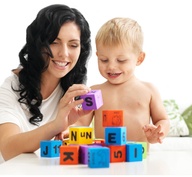Preschool Speech and Language
 “Speech” refers to saying a variety of sounds clearly while “language” refers to expressing oneself with words and gestures, and understanding words and sentences. A speech and/or language delay occurs when a child doesn’t meet the typical developmental milestones for their age (see below for milestones).
“Speech” refers to saying a variety of sounds clearly while “language” refers to expressing oneself with words and gestures, and understanding words and sentences. A speech and/or language delay occurs when a child doesn’t meet the typical developmental milestones for their age (see below for milestones).
What causes a speech and language delay?
Most speech and language delays have unknown causes. There are some factors that contribute to early speech and language difficulties (e.g., family history, premature birth, low birth weight, intellectual disabilities, cerebral palsy, Down syndrome, hearing loss, etc.), but many times, no obvious cause can be determined.
How can a Speech-Language Pathologist (SLP) help?
SLPs have training to thoroughly assess and treat your child’s verbal expression (i.e., vocabulary and early grammar use), understanding of language, and speech sound inventory (i.e., the specific sounds that your child is and is not producing).
Is there anything I can try myself?
Stimulating speech and language in preschoolers is done through play. There are a number of strategies that parents and caregivers can use, such as:
- Modeling refers to restating the child’s comment and adding a few words, thereby making the comment just a little more mature. For example, if a child says, “bue ba”, you can model, “I want the blue ball.”
- Expansion refers to adding information to a child’s comment, thereby modeling more advanced grammar and/or vocabulary. For example, if your child points to the kitchen cupboard and says, “wan acku!” you can expand on his comment and say, “I want an animal cracker!”
- Self-Talk and Parallel Talk refer to talking about what you and your child are doing as you are doing it. For example, as you dress your child, you can include such comments as, “we have to get our socks out of the drawer. Here are the socks; they go on your feet. We need to pull them up! There, your socks are on!” Or, as a child plays with trucks, parallel talk can include comments such as, “You chose the red truck! Boy, you are driving it carefully on that ramp. Oops, it crashed!”
| What speech and language skills should you expect? | |
|---|---|
| By 6 months |
|
| By 12 months |
|
| By 18 Months |
|
| By Age 2 |
|
| By Age 3 |
|
| By Age 4 |
|
| By Age 5 |
|
